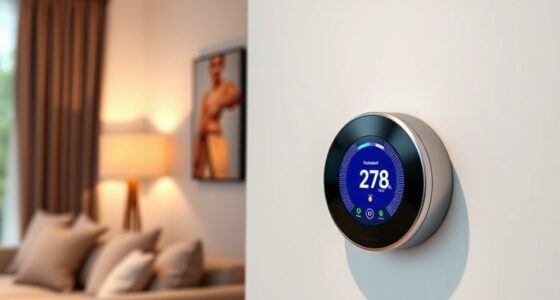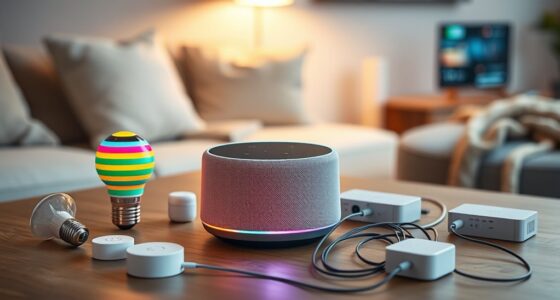LiDAR in robot vacuums allows you to map your home quickly and accurately. It uses laser sensors to scan your space in real time, creating detailed floor plans while avoiding obstacles and adjusting on the fly. This technology guarantees efficient cleaning in complex layouts and keeps your belongings safe. With LiDAR, your vacuum can navigate systematically, cover every inch, and adapt to changes. Keep exploring to discover how this cutting-edge tech can make cleaning smarter and easier.
Key Takeaways
- LiDAR enables rapid, detailed scanning of home environments for accurate and quick mapping.
- It allows robot vacuums to navigate systematically, avoiding obstacles and covering every area efficiently.
- High-resolution mapping facilitates zone cleaning, boundary detection, and targeted area management.
- LiDAR helps adapt to environment changes, such as moved furniture or new obstacles, in real-time.
- The technology improves cleaning speed and coverage, especially in larger or complex home layouts.

LiDAR technology has become a game-changer for robot vacuums, enabling them to navigate your home more accurately and efficiently. By using laser sensors to scan your environment, these vacuums create detailed maps of your living space at light speed. This process dramatically improves mapping efficiency, allowing the robot to understand the layout quickly and with minimal errors. Instead of relying on random movement, your robot now navigates systematically, covering every inch of your floors without missing spots or wasting time revisiting areas unnecessarily. The precise mapping helps optimize cleaning routes, making the process faster and more thorough.
In addition to speed, LiDAR enhances obstacle detection, which is vital for safe and effective cleaning. As your robot sweeps through your home, its laser sensors continuously scan for furniture, walls, and other objects, instantly identifying potential obstacles. This real-time detection prevents collisions and protects your belongings from damage. The robot can also recognize dynamic obstacles like pets or humans, adjusting its path accordingly without interruption. Because the LiDAR system updates its map on the fly, the robot adapts seamlessly to changes in your environment, such as moved furniture or new obstacles.
Moreover, the high-resolution maps generated by LiDAR enable advanced features like zone cleaning and customized routines. The system’s ability to accurately detect room boundaries ensures precise cleaning in designated areas while avoiding others. The combination of high mapping efficiency and advanced obstacle detection means your robot vacuum spends less time getting lost or stuck and more time cleaning. It can create a detailed floor plan in a single session, which it then uses to plan the most efficient route for each cleaning cycle. This means less redundancy and more coverage, especially in larger homes or complex layouts. Thanks to LiDAR, your vacuum can also identify no-go zones or sensitive areas you wish to protect, ensuring it avoids those spaces entirely.
Furthermore, the detailed maps generated by LiDAR enable features like targeted cleaning and zone setting. You can designate specific areas for more frequent cleaning or exclude certain zones from the routine. This level of control improves your overall cleaning experience, as the robot adapts to your needs and preferences. Plus, with advanced obstacle detection, it can navigate narrow passages or around delicate objects without causing damage, giving you peace of mind.
Frequently Asked Questions
How Does Lidar Compare to Camera-Based Navigation Systems?
You might wonder how LiDAR compares to camera-based navigation systems. LiDAR provides accurate depth perception and obstacle detection by using laser pulses, which work well in low light or complex environments. Cameras rely on visual data, which can be affected by lighting or visual obstructions. Overall, LiDAR offers more precise mapping and obstacle detection, making it a reliable choice for faster, more efficient navigation in your robot vacuum.
Can Lidar Detect Small Objects Like Cables or Pet Toys?
You might wonder if LiDAR can detect small objects like cables or pet toys. While LiDAR excels at mapping large structures quickly, its small object detection and cable identification capabilities are limited. It may struggle to pick up tiny items due to its range and resolution constraints. So, for catching small objects or identifying cables, relying solely on LiDAR isn’t enough—you’ll need additional sensors or cameras for better accuracy.
What Maintenance Is Required for Lidar Sensors?
You need to regularly maintain your LiDAR sensors to keep them functioning at their best. This includes sensor calibration, which guarantees accurate mapping, and dust removal, as dust or debris can obstruct the sensor’s view. Use a soft cloth or compressed air to gently clean the sensor surface. Schedule these steps monthly or as needed, especially if you notice your robot vacuum’s mapping becomes less precise or if it struggles to detect objects.
How Does Lidar Perform in Low-Light or Dark Environments?
You might think darkness hinders LiDAR, but surprisingly, it excels in low-light conditions. During night time accuracy, you’ll find obstacle detection remains sharp, as LiDAR uses laser pulses rather than relying on ambient light. This means your robot vacuum navigates with precision even in pitch-black rooms. So, rest assured, darkness doesn’t dim its performance—LiDAR’s laser technology keeps it on track when your home is cloaked in night.
Are There Privacy Concerns With Lidar-Equipped Robot Vacuums?
You might worry about privacy concerns with lidar-equipped robot vacuums, but manufacturers often address these issues through data security measures. While they collect mapping data to improve cleaning, they typically store it securely and avoid sharing it without your permission. To protect your privacy, check the device’s privacy policy and settings, and choose models that prioritize data security, giving you peace of mind while your home gets cleaned efficiently.
Conclusion
With LiDAR technology, robot vacuums can map your home up to 10 times faster than traditional methods, saving you time and effort. Imagine your vacuum creating a detailed map in just minutes, so it can navigate efficiently and avoid obstacles. This innovative tech not only makes cleaning smarter but also more precise. As LiDAR becomes more common, expect your home to be mapped at lightning speed, making chores easier and more convenient than ever before.









